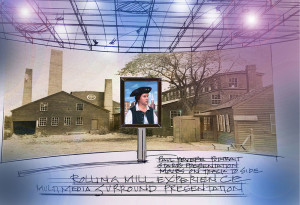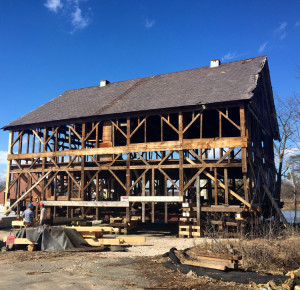Revere Commission greenlights museum proposal
By Jay TurnerTalking portraits, state-of-the-art exhibits, a “destination” restaurant and taproom, a true village green — it’s all part of the bold vision for the future Paul Revere Heritage Site and cultural center off Neponset Street, and it is rapidly moving into the realm of possibility, armed with the backing of the influential Revere Heritage Commission and its building use subcommittee.

A sketch of a ‘talking portrait’ with the Revere mill in the background. Portrait of David Connor as Paul Revere by Courtney Skinner
Unveiled to the public at a joint meeting last month at Town Hall, the ambitious proposal, which is the brainchild of commission members George Comeau and Bruce Beckham, calls for a museum complex, public gathering space, artisans cooperative, and a restaurant/bar, all blended seamlessly together on a nine-acre parcel that was once the site of America’s first copper mill.
As Comeau told the audience during his presentation in January, “This [would be] a regional attraction, and the idea is that this is something that we do as a legacy project — a legacy that started with Paul Revere but continues with us.”
While still very much in the conceptual stages, Comeau and Beckham said they have already received some seed money from supportive donors and have a number of industry experts lined up who are willing to offer their guidance and expertise.
But it was the unanimous vote of confidence they received last week from their fellow commission members, and subsequently the building use committee, that suggests that the project, in the words of Comeau, is about to “get real.”
Specifically, the two groups voted to make the proposed museum and cultural complex, which would be housed in the historic Revere rolling mill and barn, as their “primary focus” and to investigate the feasibility of such a use from both a financial and legal standpoint.
Along those lines, the two groups agreed to do further work on a business plan for the project while also looking further into a proposed “public/private partnership,” which would require the establishment of a 501c3 nonprofit organization and a long-term lease agreement with the town.
Commission member Victor Del Vecchio, who made the motion to support the museum complex, recommended that the groups take the next several weeks to examine these issues with the goal of making a presentation before the full Board of Selectmen by the end of April.
At the same time, Del Vecchio and his fellow members also reaffirmed their commitment to the School Department, which had originally eyed the rolling mill as a possible future home for school administration. Del Vecchio stressed that they should consider all options for a new school building — either on the heritage site itself, adjacent to the site, or in “some other location that would be suitable to the School Department.”
“If we need to give space to the schools on that site, then we give space to the schools on that site,” he said. “I think it would work marvelously; it would not be out of context.”
School Committee member John Bonnanzio, who serves on the building use committee and who had originally proposed the rolling mill as a location for the schools, seemed to embrace this new direction while acknowledging that the mill is perhaps better suited for historical uses.
Bonnanzio, in fact, said he has changed his mind about the proposed museum structure and is now “all for” the idea, provided that it is done correctly and with proper planning.
“I’ve definitely morphed,” he said. “I’ve gotten very excited about this thing over time, and I really do believe it’s the right thing for us to do.”
Bonnanzio did say that he would like to see outside experts play a significant role in the project, and he cautioned the proponents about the tendency to “overestimate the interest” and “underestimate how much money it actually takes to do it.”
“I would hate for this site,” he said, “despite our enthusiasm for it and respect for the site, I’d hate for this thing to wind up essentially usurping every dollar that we have in the Community Preservation fund because we haven’t taken the care to fund this thing properly — because there are many other needs in the town.”
Yet Comeau assured Bonnanzio and others that they do intend to “cast a wide net” in searching for the right people to develop and operate the project. In addition, he said they continue to receive guidance from experts in the museum and tourism industries and are constantly tweaking the plan based on their input.
As an example, Comeau said they came up with the idea of putting a restaurant and taproom in the Revere barn and an artisans’ workshop on the second floor of the mill based on feedback they received from Nina Zannieri, the executive director of the Paul Revere House in Boston. Comeau said Zannieri loved the idea for the project, but felt that the museum would not survive without additional revenue sources.
Regarding the museum itself, Comeau, who is an authority on Canton history, has proposed an interactive experience that celebrates the contributions of Paul Revere in Canton and the industries that he helped forge.
Comeau said it would be structured around different storylines, from Revere’s supervision of a powder mill on the site during the Revolutionary War to the development of his copper mill and bell foundry, to the successor companies that call Canton home today.
And it would all happen in a “very methodical way,” supported by “wonderful artifacts” and modern storytelling techniques, he said.
As for the proposed timeline for a project such as this, Comeau said it would likely take seven or more years to complete. Yet there are people both in Canton and beyond who are willing to do the work, he said, and he is hopeful that the selectmen will follow suit and offer their endorsement.
Del Vecchio, for one, is genuinely excited about the possibilities being proposed, calling it a once-in-a-lifetime opportunity and a “wonderful history lesson” for the town.
“It is a legacy,” he said. “Downtown with Walgreens? That [area] was once owned by the town. Imagine if that was kept by the town? We lost that opportunity, but if I can end my career on the Board of Selectmen by saying that I helped bring in something that evolves after I’m gone, that’s a wonderful heritage, a wonderful legacy from my perspective.”
Short URL: https://www.thecantoncitizen.com/?p=32649











